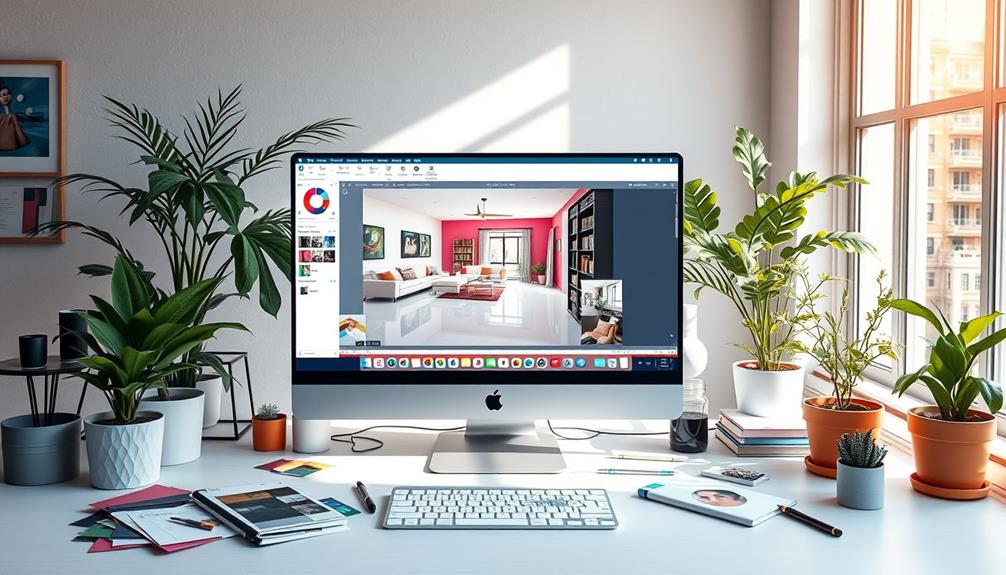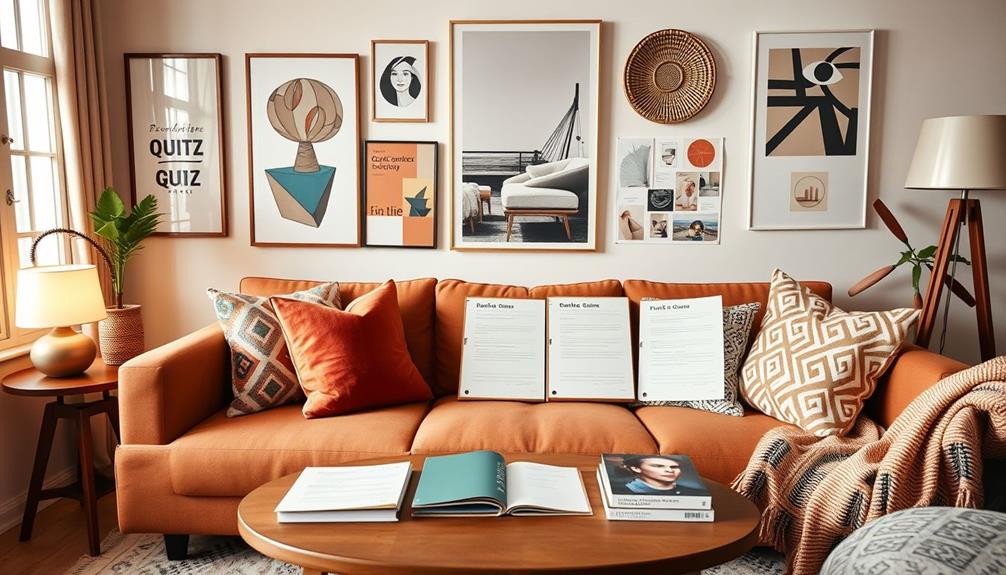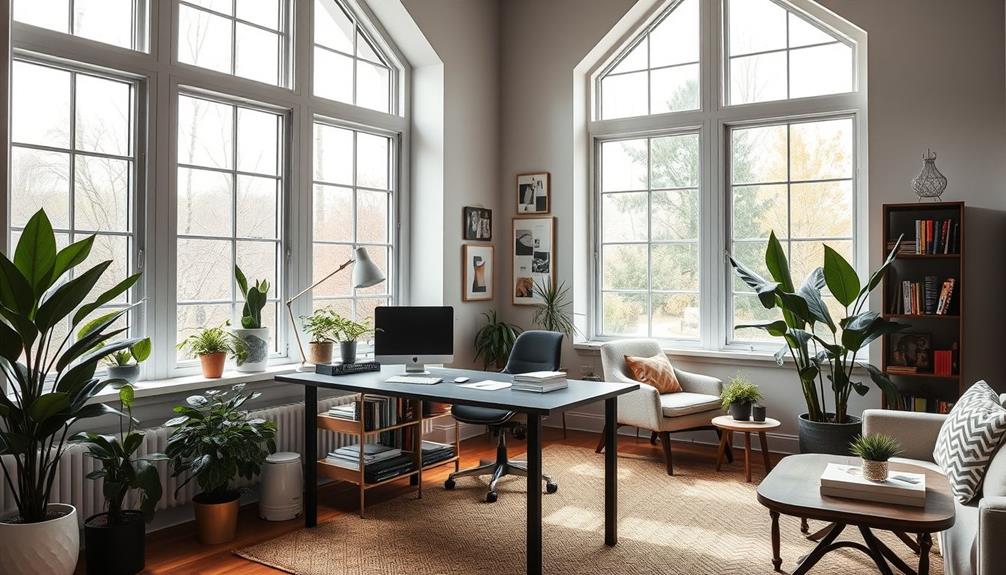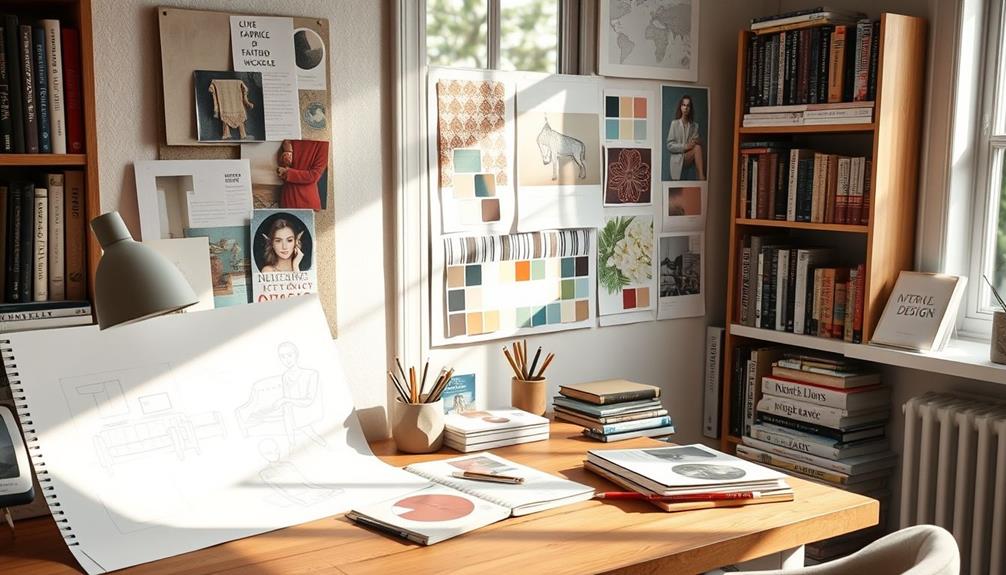You can create beautiful 3D interior designs for free by using user-friendly software like Planner 5D and HomeByMe. These platforms offer extensive libraries filled with furniture and decor options, making it easy to customize your spaces. You can drag and drop items to see how they fit into your design, and both 2D and 3D visualization options help you evaluate your ideas. Plus, joining online communities allows you to share your designs for feedback and inspiration. If you want tips to maximize your design experience, there's plenty more to discover. You can even learn 3D interior design techniques through tutorials and guides offered by these platforms, helping you refine your skills and bring your visions to life. Experimenting with color schemes, lighting setups, and spatial arrangements enables you to create designs that are both functional and stylish. Whether you’re a beginner or an experienced designer, these tools empower you to transform your ideas into stunning virtual spaces with ease.
Key Takeaways
- Utilize free design software like HomeByMe, Planner 5D, and RoomSketcher for 2D and 3D interior design capabilities.
- Explore extensive asset libraries to access thousands of furniture and decor items for your designs.
- Engage with online design communities to gain inspiration and feedback on your projects.
- Experiment with customizable features to adjust colors, materials, and layouts to suit your style.
- Take advantage of mobile apps for real-time project management and cloud synchronization across devices.
Overview of Free Design Software
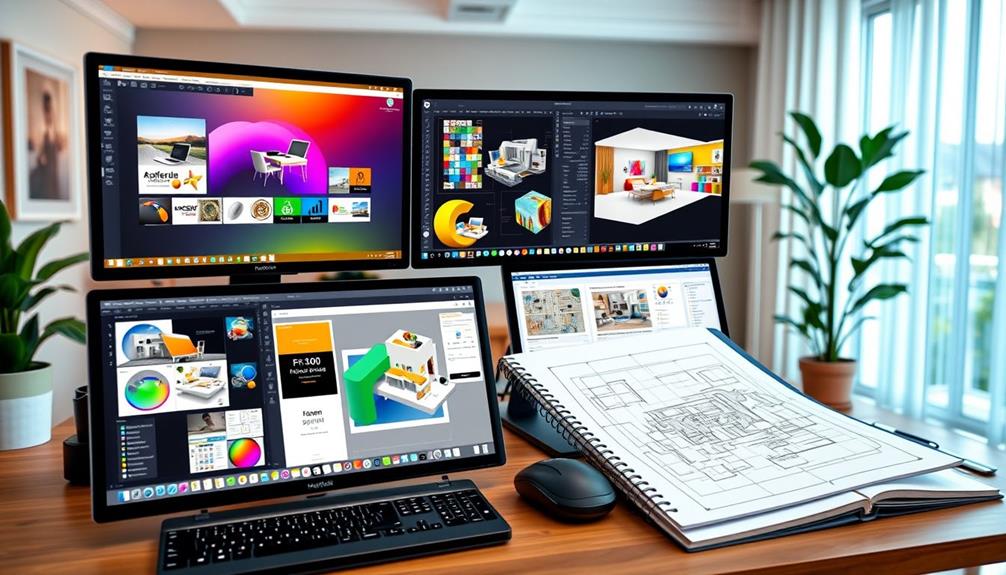
When you're diving into 3D interior design, choosing the right software can make all the difference. In 2024, several free versions of interior design software stand out, including HomeByMe, Planner 5D, and RoomSketcher. These tools provide both 2D and 3D visualization options, allowing you to see your designs come to life.
User-friendly interfaces are a hallmark of these free design tools. With drag-and-drop functionality, you can easily manipulate furniture and decor without needing prior design experience. Each platform typically comes with extensive libraries filled with furniture and decorative objects, giving you a wealth of options to customize your space realistically.
While the free versions offer great entry points, they often come with limitations. You might find reduced asset availability or restricted customization options, nudging you to evaluate premium upgrades for more advanced features.
However, most platforms allow you to create and share your designs online, which opens up opportunities for collaboration and valuable feedback from the community or clients. Overall, these free tools empower you to explore your creativity in 3D interior design without breaking the bank.
Key Features of 3D Tools

When exploring 3D design tools, you'll appreciate their user-friendly interfaces that make it easy to create stunning layouts.
With plenty of customization options, you can personalize your space to match your style perfectly.
Plus, high-quality rendering capabilities allow you to visualize your designs in realistic detail before making any changes.
User-Friendly Interface Design
A multitude of free 3D interior design tools offer user-friendly interfaces that make the design process accessible to everyone, from novices to seasoned professionals.
These intuitive tools simplify navigation and empower you to bring your ideas to life without any technical hassle. For instance, if you're inspired by a modern farmhouse bedroom, incorporating serene elements into your design can enhance the overall atmosphere.
Here are some key features that enhance usability:
- Drag-and-Drop Functionality: You can easily place furniture and decor items into your designs, making the process quick and enjoyable.
- Comprehensive Libraries: Access a vast selection of furniture, materials, and decorative objects to visualize your spaces effectively and spark creativity.
- Real-Time Rendering: See immediate updates as you make changes, allowing you to refine your designs on the fly.
With these user-friendly interface features, you'll find that the tools to create stunning 3D interiors are right at your fingertips.
Whether you're designing your dream home or a professional space, these resources make it easier than ever to bring your vision to life.
Immerse yourself and explore the possibilities that await you in the world of 3D interior design.
Customization and Personalization Options
Customization and personalization options are key features that set free 3D interior design tools apart, offering you the freedom to create spaces that truly reflect your style.
With platforms like HomeByMe and Planner 5D, you can modify colors, patterns, and materials for furniture and decor, allowing you to create stunning interiors that are uniquely yours.
You'll find access to extensive libraries featuring over 5,000 items, giving you countless choices for furnishings and decorative elements. This variety guarantees that you can personalize your designs to match your vision perfectly.
Additionally, tools like RoomToDo let you draw directly on uploaded blueprints, enhancing accuracy and enabling customized configurations based on your existing layouts.
Moreover, many platforms allow for custom furniture creation and provide a wide selection of finishing materials, so your designs can reflect your personal style in detail.
The user-friendly interfaces of these 3D design tools make the customization process straightforward, even for those without prior design experience.
Embrace these options to transform your ideas into reality, creating stunning spaces that feel like home.
High-Quality Rendering Capabilities
In today's digital age, high-quality rendering capabilities are essential for creating impressive 3D interior designs. With the right tools, you can produce visuals that captivate and inform. Here's what you should look for:
- Realistic Visuals: Advanced rendering options help you achieve rich colors and detailed textures, making your designs come alive.
- Natural Lighting and Shadows: Platforms like HomeByMe and Cedreo simulate lighting effects, providing true-to-life representations of your spaces.
- 360-Degree Panoramic Views: Generate virtual tours that enable you to visualize designs and layouts before implementation.
Utilizing these high-quality rendering capabilities not only enhances your project presentation but also aids in effective decision-making.
The inclusion of HD images allows you to showcase your design choices clearly, making it easier to communicate your vision.
Additionally, you can create multiple rendering styles and perspectives, giving you the flexibility to highlight various aspects of your interior designs.
Embracing these features will elevate your 3D design process, ensuring your projects stand out in a competitive market.
Top Free Interior Design Platforms
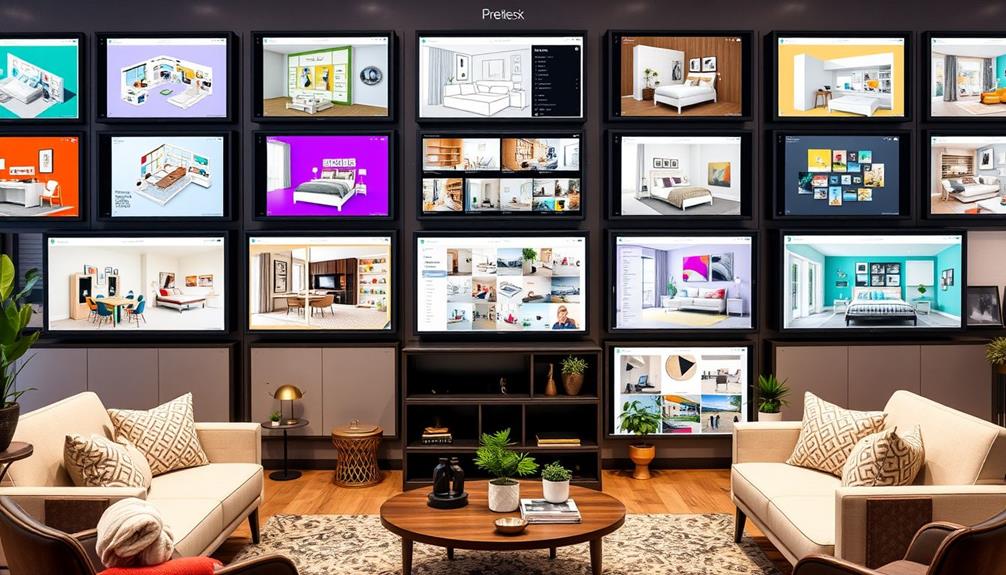
When it comes to transforming your interior design ideas into stunning 3D visuals, several platforms can help you achieve just that without breaking the bank.
HomeByMe is an excellent choice, offering an online service where you can create high-quality 3D designs. While it has a free plan, be aware that some features are limited.
Another great option is Planner 5D, a user-friendly platform that allows you to work in both 2D and 3D. It's free, but advanced features might require a subscription.
For those looking to create professional floor plans, RoomSketcher lets you visualize designs in 3D with a basic free version.
If you're an architect or interior designer, consider Cedreo; it offers a free plan for creating 2D and 3D floor plans, though with limited assets.
Finally, DreamPlan Home Design is a downloadable program that allows you to quickly create home designs and landscapes in 3D, featuring a free version with a restricted object library.
These platforms make it easy for you to explore home design and interior decoration without spending a dime.
User Registration and Access Levels
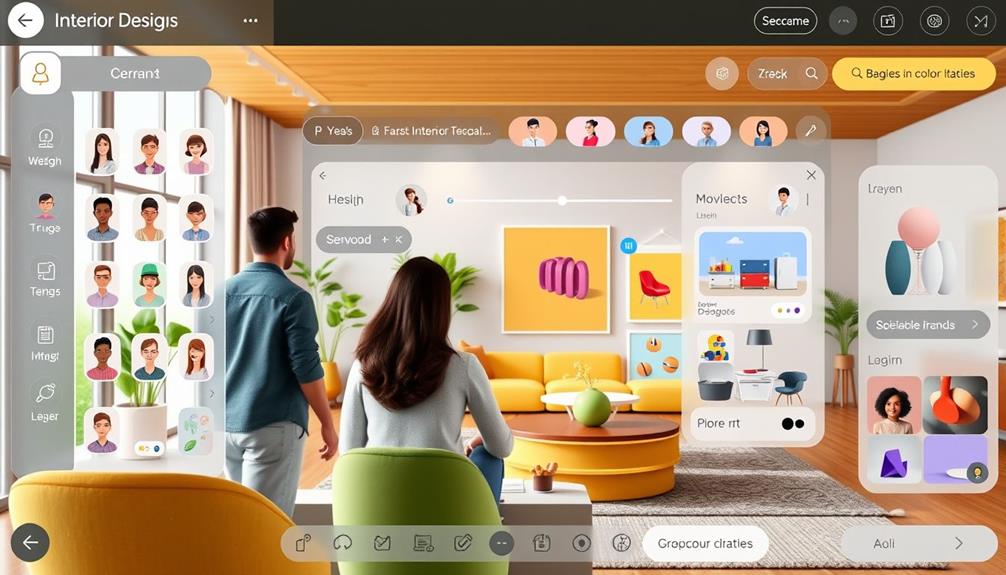
Registering for free access to interior design tools is straightforward and convenient. You can sign up using your Email, Apple, Google, or Facebook account, ensuring your password is secure.
Once registered, you'll encounter different access levels that define your design experience.
Here's what you can expect with user registration:
- Free Access: Limited to 5% of interior items, with restrictions on color, material, and size editing. It's a great way to start but can feel limiting.
- Premium Access: Grants access to a whopping 6,435 interior items and full customization options. This greatly enhances your design experience, allowing you to create more personalized spaces.
- Upgrade Incentives: The platform clearly outlines the distinctions between free and premium features, encouraging you to reflect on an upgrade for access to advanced design tools and a richer library of items.
Exploring User-Created Content

User-created content serves as a treasure trove of inspiration for anyone immersing themselves in the world of interior design. By exploring user-generated content, you can uncover a vast array of styles and themes that might spark your creativity, including popular trends like modern farmhouse decor with its emphasis on neutral palettes and natural materials.
These images showcase real-life applications of various design tools and demonstrate how different layouts and furnishings can transform spaces effectively.
When you engage with communities that share their designs, you not only find motivation but also gain valuable feedback. This constructive criticism can help refine your projects, making them more polished and impactful.
As you explore these platforms, keep an eye out for unique furnishings and decor elements that mightn't be featured in standard design catalogs. You could stumble upon something truly special that elevates your project.
Moreover, this exposure to diverse ideas encourages innovation, allowing you to brainstorm and visualize your own design concepts.
High-Definition Visualization Options

High-definition visualization tools let you generate realistic images that bring your interior design ideas to life.
With these enhanced visuals, you can make better design decisions and communicate your vision more effectively.
Many free software options offer impressive rendering capabilities, helping you showcase your projects with stunning detail.
Realistic Image Generation
Realistic image generation is a game changer in interior design, transforming your projects with stunning visuals that truly reflect the colors, textures, and materials you choose.
With high-definition visualization options, you can create immersive images that help your designs stand out. These tools not only enhance the aesthetic appeal but also support your design decisions.
Here are three key benefits of utilizing realistic image generation in your projects:
- Accurate Representation: High-definition visuals showcase your design ideas precisely, ensuring that clients see exactly what you envision.
- Cost-Effective Evaluation: You can produce up to 60 realistic renders in premium software versions like HomeByMe, allowing you to assess different options before implementation, thereby minimizing costly mistakes.
- Effective Presentations: High-quality imagery makes it easier to present your concepts to clients and stakeholders, enhancing your communication and increasing buy-in for your ideas.
Enhanced Design Decision-Making
With the ability to generate stunning visuals, your design process can become markedly more intuitive and informed. High-definition visualization options allow you to create realistic imagery that mimics actual materials and lighting conditions, which is vital for accurate decision-making. This capability helps you evaluate design choices thoroughly before implementation.
Here's a quick overview of the benefits of HD visualization:
| Feature | Benefit | Impact on Design Process |
|---|---|---|
| Realistic Renders | Up to 60 realistic options | Enables thorough evaluation |
| Enhanced Presentations | Improves communication | Makes concepts clearer for clients |
| Flaw Identification | Highlights potential issues | Allows for adjustments before changes |
| Creative Exploration | Encourages style experimentation | Leads to more confident decisions |
Using high-quality rendering can transform your presentations and marketing materials, making them more engaging. You'll find that these realistic visuals not only enhance your ability to visualize spaces effectively but also empower you to explore different styles and layouts. Ultimately, this leads to more informed design decisions, ensuring your projects align with your creative vision.
Community Feedback and Support

Engaging with a vibrant community can greatly elevate your 3D interior design journey. By connecting with others, you can receive valuable community feedback that helps refine your concepts and enhances your creative process.
Online sharing platforms like HomeByMe allow you to showcase your work and gain insights from friends, family, and fellow designers.
Participating in design battles is another fantastic way to engage with the community. These friendly competitions not only help you gain recognition for your creativity but also inspire you to push your design boundaries.
Here are three ways to leverage community support:
- Feedback Exchange: Share your designs and ask for constructive criticism. This input can lead to improvements you mightn't have considered.
- Idea Brainstorming: Browse user-generated content for inspiration. Diverse designs can spark new ideas and help overcome creative blocks.
- Collaborative Problem Solving: Join community forums to troubleshoot challenges together. Collaborating with others can lead to innovative solutions.
With a supportive network behind you, your 3D interior designs will flourish, making the process more enjoyable and rewarding.
Mobile Design Management

With mobile design apps, you can create and manage your 3D interior design projects whenever inspiration strikes.
These tools not only offer flexibility but also let you sync your work seamlessly across devices.
You'll find it easier than ever to visualize and adjust your designs on-the-go.
On-the-Go Design Flexibility
Leveraging mobile design apps, like HomeByMe, transforms how you approach interior design projects. With these tools, you gain unparalleled flexibility, allowing you to design anytime, anywhere. The intuitive interfaces make them easy to use, helping you manage your projects seamlessly.
Here are three advantages of on-the-go design flexibility:
- Real-Time Adjustments: Access 3D design tools from your mobile device to visualize ideas and make instant changes, ensuring your vision is always on track.
- Cloud Synchronization: Save your work in the cloud, enabling you to access projects across devices. Whether you're online or offline, your designs are always at your fingertips.
- Collaboration Made Simple: Easily share your designs with friends, family, or clients for quick feedback. This fosters a supportive environment that enhances your design process.
With mobile design apps, you can brainstorm, create, and refine your projects as inspiration strikes. The on-the-go capabilities empower you to engage with your design in ways that were previously unimaginable, making interior design an exciting and dynamic experience.
Inspiration Anytime, Anywhere
Inspiration can strike at any moment, and having a mobile design management app makes it easy to capture those ideas wherever you are. With this app, you can create and manage your 3D interior design projects on-the-go, fitting seamlessly into your busy schedule.
You'll find inspiration anytime, anywhere, thanks to a wealth of user-generated content accessible right from your mobile device, complemented by exclusive design insights that can spark new ideas. The 3D design tools available on the platform empower you to visualize your concepts and make adjustments in real-time.
This flexibility encourages you to brainstorm and implement ideas as they come to you, ensuring that creativity flows without interruption. Whether you're on a break at work or waiting in line, you can immerse yourself in your projects and bring your visions to life.
Plus, with cloud storage, your projects sync across devices, letting you shift easily from your mobile to desktop without losing any work. This means you can keep the momentum going, no matter where you are.
Embrace the freedom to create and explore your interior design ideas whenever inspiration strikes.
Seamless Project Synchronization
Enhancing your design experience, seamless project synchronization allows you to effortlessly switch between devices while working on your 3D interior designs.
With mobile design management, you can easily create and edit your projects on-the-go, ensuring flexibility and convenience throughout your design journey. Here are three key benefits of this approach:
- Cross-Platform Compatibility: Platforms like HomeByMe let you access your projects across smartphones, tablets, and computers, making it simple to continue your work whenever inspiration strikes.
- Real-Time Cloud Storage: Save and synchronize your designs in real-time, preventing data loss and enabling smooth collaboration with your team members.
- Offline Access: Mobile apps allow you to work offline, so you can keep making progress on your easy design projects even without an internet connection.
This integration of mobile project management tools keeps you engaged with your designs, empowering you to adjust and find inspiration anytime, anywhere.
Embrace seamless project synchronization, and watch your creativity flourish as you navigate your 3D interior design projects with ease!
Professional Services and Options
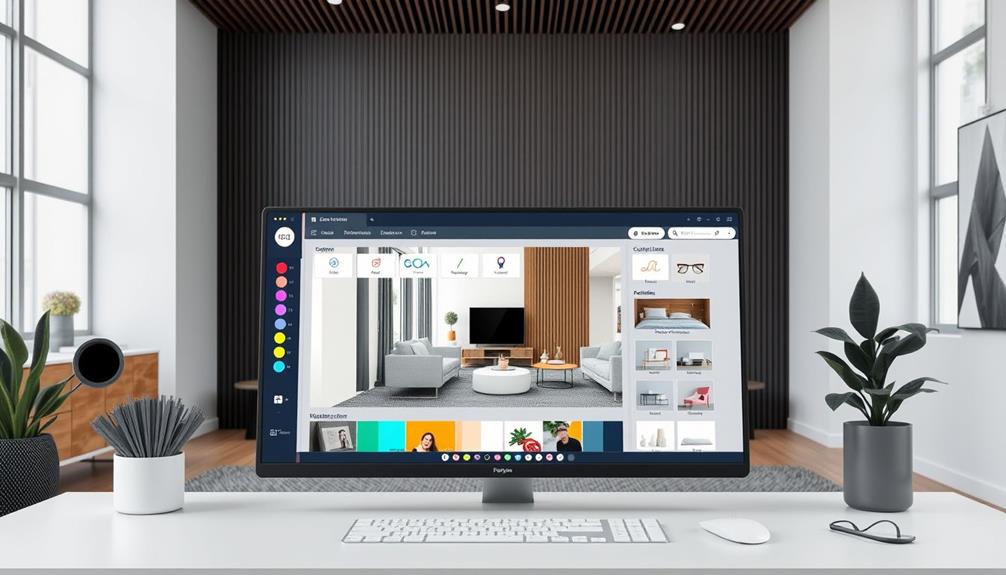
When you're short on time or need expert guidance, professional design services can be a game changer for your 3D interior design projects. Platforms like HomeByMe and RoomToDo offer professional services starting at just $99, providing tailored assistance to help you create stunning 3D plans.
Incorporating elements of Cottagecore Home Office can enhance the serenity and coziness of your workspace, promoting mental well-being as you design. If you find yourself pressed for time, hiring an interior designer guarantees that your designs follow industry standards and regulations, giving you peace of mind.
Many of these services also feature unlimited revisions, allowing you to refine your design until it perfectly meets your vision. For specialized areas, like kitchen planning, average costs hover around €139, reflecting the value of incorporating expert insights that lead to functional and aesthetically pleasing spaces.
Additionally, several design tools come equipped with troubleshooting support and detailed guidance for common design issues, enhancing your overall project experience.
Tips for Maximizing Free Tools
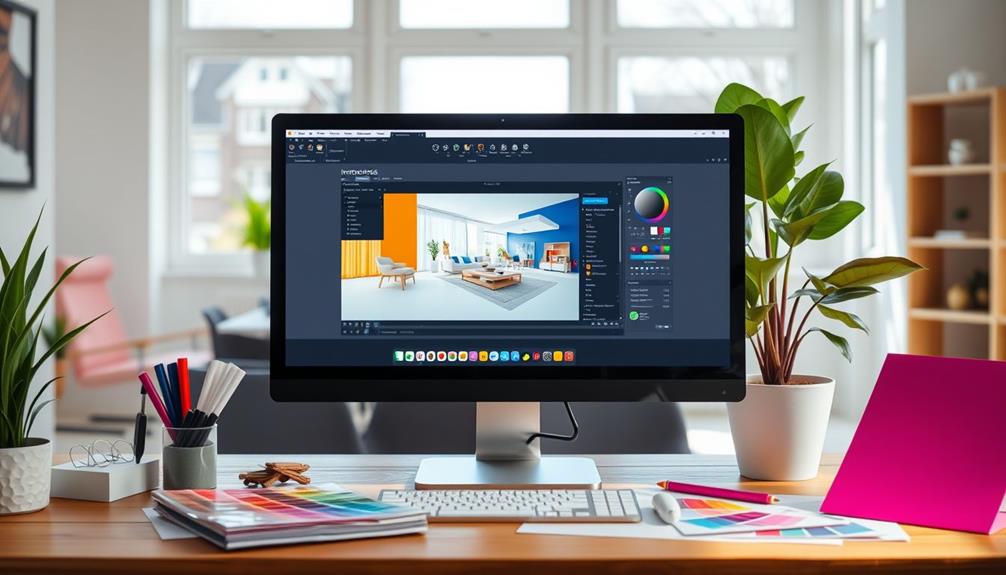
Maximizing free tools can transform your 3D interior design experience, making it more enjoyable and productive. By leveraging the right free software, you can effectively design your home without breaking the bank. Here are some tips to get the most out of these resources: Additionally, utilizing free online tutorials and forums can provide valuable guidance and support as you navigate the world of 3D interior design. These resources can help you master various software tools and techniques, ultimately equipping you with the skills needed to excel in this field. Whether you’re designing for personal use or starting an interior design business, harnessing free tools can be a game-changer in achieving your design goals.
- Explore Platforms: Try out robust free tools like HomeByMe and Planner 5D. They offer both 2D and 3D design capabilities, helping you visualize your interior spaces effectively.
- Utilize Community Support: Engage with user-generated content on these platforms. You'll find inspiration and feedback from others that can refine your design ideas and enhance creativity.
- Take Advantage of Libraries: Use the extensive libraries of furniture and decor items available in free software like RoomSketcher. These resources add authenticity and personalization to your designs, making them more appealing.
Moreover, experiment with layouts in drag-and-drop interfaces, allowing you to modify designs easily.
Conclusion
In summary, diving into 3D interior design with free tools can feel like unearthing hidden treasures in your own home. You've got the resources at your fingertips to create stunning spaces without breaking the bank. By exploring various platforms and engaging with the community, you'll find inspiration and support along the way. So go ahead, release your creativity and transform your vision into reality—your dream space is just a few clicks away!
